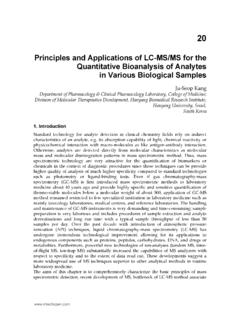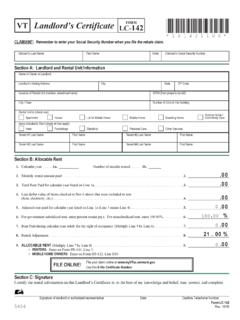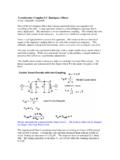Transcription of Throttle Position Sensor Adjustment - LC Engineering
1 2031 Holly Avenue, Lake Havasu City, AZ 86404 Office Fax Throttle Position Tech & Adjustment Procedure The Toyota 22RE and 3VZ engines are electronically fuel injected. As such they lack a mechanical carburetor and instead split the function of the carburetor into three parts, namely the air flow meter in the air cleaner box, the Throttle body and the fuel injector. The air flow meter uses a flapper vane and temperature Sensor to detect the temperature and velocity/flow of the incoming air charge. The Throttle body controls the airflow into the engine and the fuel injectors supply the proper amount of fuel to the engine depending upon operating conditions. The Throttle body contains the Throttle valve that it operated by the accelerator pedal in the driver's compartment.
2 The valve serves to regulate the amount or air that gets introduced into the engine. The fuel injectors spray atomized fuel into the intake of each cylinder in response to an electrical signal from the engine computer (ECU). One determining factor (among many) for the amount of fuel to inject is based upon the Position of the Throttle valve, which is determined by the Throttle Position Sensor (TPS). Periodically, the Throttle body should be cleaned or checked for a buildup of sludge that may clog the air bypasses, vacuum ports, or prevent the Throttle plate from closing to its proper Position . This should be checked prior to any Adjustment of the. Crankcase vapors are commonly vented into the Throttle body for re-introduction into the combustion process (by the Exhaust Gas Recirculation, or EGR, valve).
3 These vapors can leave an oily residue on the back of the Throttle pate and allow sludge and dirt to accumulate. The Throttle body can easily be cleaned while on the vehicle with a little carburetor cleaner and a cloth or Throttle body cleaners. However, for heavy sludge buildup, it should be completely removed, washed in solvent, and dried thoroughly. When doing this, it is important that the TPS should be removed to prevent contamination (a primary cause for failure) and the Throttle body-to-plenum gasket replaced. We strongly recommend cleaning your Throttle body thoroughly before attempting any Adjustment . The Toyota 22RE engines use a "Linear" Throttle Position Sensor . The Sensor basically looks at idle or closed Throttle (IDL) and Throttle angle opening (VTA).
4 The TPS itself is simply a linear variable resistor that when driven by the ECU produces a linear voltage in a 0-5 volt range, 0 volts being idle and up to 5 volts representing Throttle opening angle. Internally, there is also a switch that detects the idle Position . Proper Adjustment of the TPS is critical for engine performance, fuel economy, and emissions. An improperly adjusted TPS affects many other inputs and outputs from the ECU, many of which would not even logically point to the TPS. Some common symptoms of a bad TPS are; erratic shifting (automatic transmission), inability to adjust timing correctly, poor Throttle response, poor fuel economy Many of these running issues can be solved by a simple Adjustment ! Aside from being out of Adjustment , the TPS can just plain wear out or break internally.
5 After you have properly adjusted the stop screw and the TPS you will need to look at the dash pot. The dash pot is designed to slow down the closing of the Throttle to prevent backfiring. It consists of a round air bellow, a spring loaded plunger, and the air vent line that attaches to the fitting at the base of the bellows. The vent line has a check valve in-line and an air filter to keep dirt out. The check valve lets air into the bellows when the Throttle opens and extends the plunger. When the Throttle closes, the stop screw contacts the plunger and pushes it in. The check valve slows down the air flow which slows down the Throttle linkage. To troubleshoot the dash Revision: 04/06/10 2031 Holly Avenue, Lake Havasu City, AZ 86404 Office Fax pot make sure the check valve air filter is clean and make sure the check valve is not clogged or stuck open.
6 You should be able to blow air into the bottom freely ( Throttle opening) but it should be harder to suck air back out of the check valve ( Throttle closing). You can clean the air filter and check valve with some soapy water, do not use any harsh cleaner like carburetor cleaner. The plunger will also stick sometimes; you can spray a small shot of silicone to helps keep it moving freely. Lube it then push it in and out fully a few times to work the lubricant down into the plunger. The Adjustment procedure for the dash pot is listed below with the TPS Adjustment (step 8). TPS Adjustment / Testing Procedure: This procedure can be done with the Throttle body installed but is much easier to do out of the vehicle. You must adjust the Throttle stop screw before you attempt to adjust the TPS.
7 1. Loosen the jam nut and unscrew the Throttle stop screw all the way so that the Throttle blade closes fully against the Throttle body itself. 2. Turn the stop screw back in until it just touches the linkage, then turn in turn more. This extra turn keeps the Throttle blade from sticking against the inner bore of the Throttle body. 3. Tighten the jam nut while holding the stop screw in place to prevent it from moving. 4. Unplug TPS 5. Loosen the TPS mounting screws just enough that you can barely move the TPS. You want to keep the TPS from moving too freely (it is easier to keep the TPS snug enough that you tap it very lightly to move it into Adjustment ). 6. Use an ohmmeter and a feeler gauge to test the TPS (test the TPS itself and not the connector side).
8 See pictures and charts below for connector pin outs and test values. a. If in doubt about the layout of the terminals an easy way to identify the proper orientation is to identify the VTA-E2 terminal pairs. E2 is at one end of the TPS or the other. VTA is one pin in from the opposite end. The VTA-E2 signal varies from a few hundred to a few thousand ohms as the TPS moves through its range of travel. So try one end of the TPS connector for E2 and see if the resistance varies properly, if not, try the other end. Once the E2 end of the connector is identified, the rest of the pins should be laid out as indicated in Figure 3. 7. The TPS Adjustment is very touchy so make sure that you make small adjustments. If the TPS fails to read the proper resistance in any tests then it should be replaced.
9 8. Adjust the dash pot by setting the plunger so that it first makes contact with the Throttle linkage about halfway back from wide open Throttle . If set too deep you will have more spring force to overcome and that can cause the Throttle to not fully close. Too shallow and the dash pot will not slow the linkage down properly. 2031 Holly Avenue, Lake Havasu City, AZ 86404 Office Fax 85-95 TPS (22RE & 3VZ) 83-84 TPS 1983 & 1984 Only Resistance Clearance Between Linkage & Stop Screw IDL - TL Psw - TL IDL - Psw ( ) Continuity No Continuity No Continuity ( )
10 No Continuity No Continuity No Continuity Wide Open Throttle No Continuity Continuity No Continuity In the above tests, you are actually simulating various Throttle positions and rotating the TPS on its base to achieve all the above conditions. Below is an explanation of these tests. Test #1 simulates the closed Throttle Position , with the Throttle valve fully closed and the Throttle stop lever in contact with the Throttle stop screw Test #2 and #3 test the transition from idle to normal operation o If you are unable to get the exact feeler gauge size then use the closest gauge you have to the value, or stack two thinner gauges to make one the right thickness 1985-1995 22RE & 3VZ Test Clearance Between Linkage & Stop Screw Between Terminals Resistance (85-88) Resistance (89-95) 22RE - ( ) 1 3VZ - ( ) VTA - E2.



